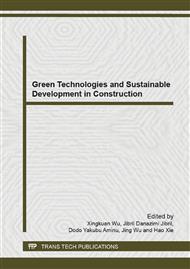[1]
D. Rahim, A Green Look At The Property Value, in Starbiz, The Star, ed: The Star, (2011).
Google Scholar
[2]
F. Fuerst and P. McAllister, An Investigation of the Effect of Eco-Labeling on Office Occupancy Rates, The Journal of Sustainable Real Estate, vol. 1, pp.49-64, (2010).
DOI: 10.1080/10835547.2009.12091793
Google Scholar
[3]
D. Harrison and M. Seiler, The political economy of green office buildings, Journal of Property Investment & Finance, vol. 29, pp.551-565, (2011).
DOI: 10.1108/14635781111150394
Google Scholar
[4]
J. A. Wiley, et al., Green Design and the market for commercial office space, Journal Real Estate Finance Economics, vol. 41, pp.228-243, (2010).
DOI: 10.1007/s11146-008-9142-2
Google Scholar
[5]
G. Newell, et al., Building Better Returns: A Study of the Financial Performance of Green Office Buildings in Australia, pp.13-47, (2011).
Google Scholar
[6]
P. Eichholtz, et al., Doing Well By Doing Good? Green Office Buildings, American Economics Reviews, vol. 100, pp.2492-2509, (2009).
DOI: 10.1257/aer.100.5.2492
Google Scholar
[7]
J. Georing, Sustainable Real Estate Development: The Dynamics of Market Penetration, Journal of Sustainable Real Estate, vol. 1, pp.167-201, (2009).
DOI: 10.1080/10835547.2009.12091794
Google Scholar
[8]
R. Rahardjati, et al., The Level of Importance of Criteria and Sub-Criteria in Green Building Index Malaysia, presented at the International Conference on Sustainable Building and Infrastructure (ICSBI 2010), Kuala Lumpur Convention Centre, (2010).
Google Scholar
[9]
T. Boyd, Can we assess the worth of environmental and social characteristics in investment property?, in Pacific Rim Real Estate Society (PPRES), Auckland, New Zealand, (2006).
Google Scholar
[10]
T. Heb, et al., Responsible Property Investing in Canada: Factoring both environment and social impacts in Canadian Real Estate Market, Journal of Business Ethics, vol. 92, pp.99-115, (2010).
DOI: 10.1007/s10551-010-0636-5
Google Scholar
[11]
A. Singh, et al., Costs and Benefits of IEQ Improvements in LEED Office Buildings, American Society of Civil Engineers, vol. 17, pp.86-94, (2011).
DOI: 10.1061/(asce)is.1943-555x.0000046
Google Scholar
[12]
N. Zainordin, et al., Users' Perception Towards Energy Efficient, Asian Journal of Environment-Behaviour Studies (ajE-Bs), vol. 3, pp.91-94, (2012).
DOI: 10.21834/aje-bs.v3i6.250
Google Scholar
[13]
K. Addae-Dapaah, et al., Sustainability of sustainable real property development, Journal of Sustainable Real Estate, vol. 1, pp.204-225, (2009).
DOI: 10.1080/10835547.2009.12091781
Google Scholar


